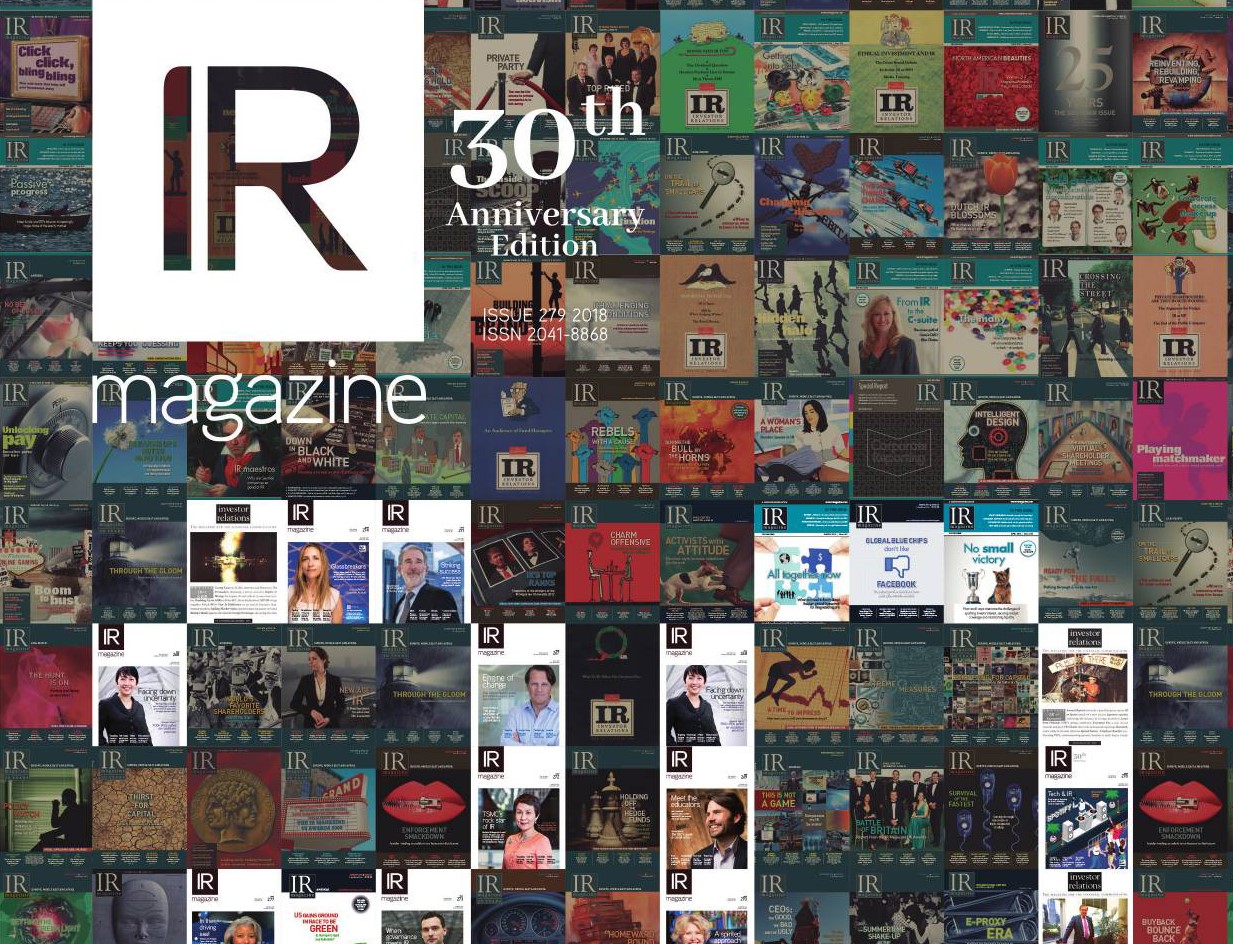In 2021, three quarters of IR Magazine cover stories focused on ESG. We looked at how companies were increasingly tying executive compensation to ESG, explored the ways in which ESG was being integrated into sell-side research and examined how ESG was shaping corporate reporting.
Of course, IR Magazine has long covered ESG issues – just as the themes that fall under this umbrella have long been covered by IR professionals. In 2011, Neil Stewart talked about ‘the great sustainability race’. A decade ago, Tim Human wrote that investors were ‘turning up the heat’ on climate change. ESG became a topic in its own right on the IR Magazine site in 2017.

But there certainly wasn’t the hyperfocus on ESG then that there is today. So what did we talk about before? Looking only at cover stories in the years before the ESG-high of 2021, we covered Covid-19 – and the rallying of big pharma in the race to vaccinate – as well as diverse topics including how stock exchanges were upping the number of events they held, shareholder ID in the world of dark pools and how an influx of retail investors was impacting the role of investor relations.
As the ESG focus has grown, however, so too has the burden on IROs. Research from Nasdaq shows that 35 percent of IR professionals now have ESG duties as well. Anecdotally, though, what we hear is that the workload and the focus on ESG fails to match up with investor interest. It also fails to match up to what IR professionals tell us their biggest challenges are.
Instead, our research shows that, post-pandemic (2022 and 2023), macroeconomics has been the biggest challenge for IR professionals (cited by 25 percent and 20 percent, respectively). Even as the number of ESG frameworks proliferate and we begin moving from voluntary to mandatory disclosures, just 8 percent (2023) and 6 percent (2022) of IR professionals cite ESG as a key challenge.
A catch-22 situation
Affryll Teo, head of IR, sustainability and M&A at Malaysian insurer Tune Protect, is one of those who has seen his ESG workload increase, adding sustainability to his official duties a couple of years ago. The firm is the only Malaysian insurance company in the FTSE4Good Index, which Teo says the company is proud of. But he also sees a lot of the drive, particularly around the reporting of company sustainability, as more to do with a ‘greening of assets by 2030’ rather than genuine investor interest.
Despite this, he says ESG is taking up more time – time that is taken from core IR activities. ‘Previously, my duties were more IR-heavy,’ he explains. ‘But now I’d say it’s 50/50. And, honestly, I think these roles will have to separate soon. It has already evolved to a point where I can see I won’t be able to juggle both portfolios.’

He points out that a lot of companies have a dedicated chief sustainability officer or head of sustainability, which is something Teo says he’ll have to make a case for with management given the increasing ‘depth and the breadth of the [ESG] role’.
So what would he be doing more of instead? ‘I would meet more often with external investors, shareholders, fund managers and analysts,’ he says, adding that the current sustainability focus involves a lot of internal engagement.
Teo also explains that despite the amount of time he spends on ESG, his efforts in targeting ESG investors haven’t borne fruit. ‘We have tried in the past, but what I’ve come to understand is that, ultimately, investors first look at whether you are a profitable company,’ he says. ‘Second to that will be how far along you are in terms of the ESG curve.’ Tune Protect came out of a full-year loss in 2022, he adds, meaning that for investors, ‘the whole ESG narrative has taken a back seat’.
When asked how often investors want to talk ESG with him, Teo says: ‘Never. It’s zero. And the ones that are really into ESG are not interested in investing in us so it’s a catch-22 situation.’
Managing the workload
Keeping up with shifting frameworks and ESG regulation – as well as the new expectations around double-materiality assessments – is one area of increasing workload; managing ESG ratings questionnaires has long been a time-drain for the IR professionals involved.
Today, ‘understanding ESG rating agencies is not an option but a requirement,’ says Marine Esperandieu, a director at SquareWell Partners. These ratings, ‘impact how investors view a portfolio company, whether for benchmarking purposes, the creation of indices or screening.
‘The trick, however, is to determine where to focus, and what would give the highest return on investment as it is a heavy burden for companies to keep up to date with all changes and requests in the ecosystem. Not all rating agencies have the same influence. We recommend that companies focus only on those that have the biggest investment impact and those you need to maintain for supplier relationships. The rest companies should respond to reactively – or even ignore – as the cost of distraction may actually be higher than a slight gain in a specific rating.’

Esperandieu adds that ‘investors may be underestimating how much of their internal resources need to be spent to keep up with such ESG ratings for companies, and there is a risk that all stakeholders spend more time on reporting and complying as opposed to focusing on actual performance and impact.’
She also points to a ‘double-edged sword’ situation in the ESG ratings world. Even as you add more investors through these ratings, these will likely be passive investors that ‘could quickly sell out when a controversy is flagged without even hearing the company’s position,’ she says. Instead, SquareWell advocates really incorporating the sustainability story into the company story.
‘A strong equity story that incorporates ESG demonstrates the value drivers (including how sustainability mega-trends are addressed as opportunities) that are communicated through a robust engagement plan (with both current investors and potential targets),’ says Esperandieu. ‘That remains the cornerstone of a successful IR strategy.’
Quitting Climate Action 100+
Added to the ESG mix are a whole host of external stakeholders assessing ESG claims, calling out greenwashing and banding together to amplify their voices. But that world is also shifting. The recent news that JPMorgan and State Street have quit Climate Action 100+, while BlackRock planned to scale back its involvement, means none of the top-five money managers now fully backs the influential investor group. How should IR professionals interpret these moves?
‘This shift, while not inherently anti-ESG, signals a nuanced recalibration toward strategies that might better withstand the current socio-political climate, where there’s a pronounced backlash against ESG-focused investments,’ explains Per-Otto Wold, co-founder and CEO of Zerolytics.

‘The retreat from traditional ESG commitments by firms like JPMorgan and BlackRock sends a complex and important message to public companies about navigating their ESG communication and engagement. It underscores the necessity for companies to be more agile and innovative in their ESG strategies, taking into account impending climate transition risks and responding to a diversifying spectrum of investor expectations amid fluctuating political landscapes.’
Being nimble in their ESG communications will be crucial in maintaining momentum toward sustainable investment, says Wold – ‘even in a climate of increasing skepticism toward traditional ESG frameworks.’
Governance is king
For some, ESG is tied too closely to a ‘woke’ agenda. For others, it has become too muddied by the pursuit of financial returns. Even those who fully support ESG goals see a need for a rethink on the way companies approach these issues – or the way they’re banded together.
Esperandieu asks which areas of the core IR function, and outside of ESG issues, warrant a renewed focus. She cites board strength and capital allocation, where, she adds, ‘investors will increasingly focus on how boards decide to allocate for growth vs returns.’
SquareWell has, for some time, called for the separation of the G pillar from the ESG umbrella, and that is a position Esperandieu says the adviser feels only more strongly about with time.
‘We do not believe a company with weak governance can sustainably perform in the long term,’ she affirms. ‘E&S topics are easier to control and manage – for example, you either have a climate action plan or you don’t. But answering whether or not you have a strong board is more nuanced – previous metrics like level of independence, diversity, skills matrix, and so on do not necessarily cut it [any more].
‘Boards need to explain the decision-making processes, inputs considered, the results delivered and mistakes made to ensure they build trust with the market. Governance is difficult to communicate solely through written disclosures, which is why it needs to be accompanied by a robust engagement program with investors.’






